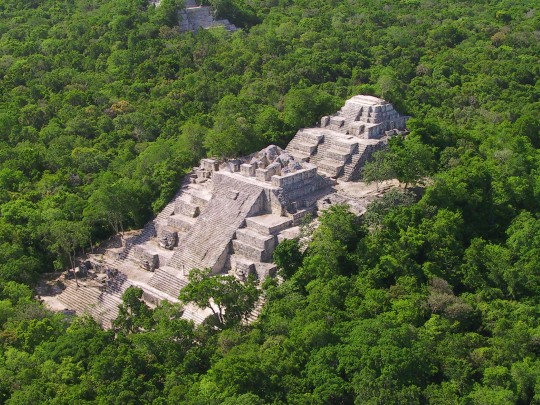Archeological Sites
17 Sites
Deep in the Campeche jungle, this site is composed of three building complexes.
The polychrome molded stucco frieze of the Central Group, unique in the Mayan area,
is proof of the artistic mastery of its ancient inhabitants.
The polychrome molded stucco frieze of the Central Group, unique in the Mayan area,
is proof of the artistic mastery of its ancient inhabitants.
Campeche
Sureste
1659
A powerful regional capital, as evidenced by its monumental constructions, Becán also boasts something found nowhere else in the Maya area: a fosse surrounding the site’s most important buildings, which has seven entrances.
Campeche
Sureste
1660
One of the largest cities in the Maya region, Calakmul is dotted by 120 stelae amid the monumental structures and pyramids. It is located in the second-largest natural reserve in the Americas, and was listed as a UNESCO Mixed World Heritage site in 2014.
Campeche
Sureste
1661
The masks of Itzamná, the god of the sun and wisdom represented by a face with enormous open jaws and bejewelled ears, appear especially grandiose, in this small ancient city where the ruling class once lived, situated on the route between the Gulf of Mexico and the coast of Quintana Roo.
Campeche
Sureste
1662
Stone carvings like gold filigree adorn the residences of those "who speak to the gods." The elaborate Puuc architectural style makes this ancient city a relic that remains almost entirely intact even after 12 centuries. Its greatest treasure is El Palacio.
Campeche
Sureste
1663
The legacy of the past grandeur of this site is an expansive plaza and splendid buildings, some decorated with carved masks. Remains of paintings have also been found, showing hieroglyphs and gods of the Maya pantheon.
Campeche
Sureste
1664
A site with magnificent architectural complexes, such as the “Great Acropolis” and impressive constructions, above all the “Building of the Five Floors." Edzná’s inhabitants developed a complex water management system to secure a year-round supply, and their city became a powerful regional capital between 400 and 1000 AD.
Campeche
Sureste
1667
Similar to Hochob, it has a building whose facade has a great mask with a monstrous open mouth with enormous fangs, which has been interpreted as an entrance to the underworld. Also worthy of note is the zoomorphic facade and the masks of the god Chaac which decorate another of the structures.
Campeche
Sureste
1671
Capital of the province of Acalán, also known as Itzamkanac, El Tigre is situated on the banks of the river Candelaria and was renowned for its trading activity. Notable is the ceremonial center with the large stucco masks. It is believed that Hernán Cortés executed Cuauhtémoc here.
Campeche
Sureste
1668














